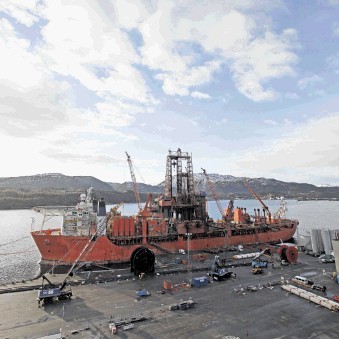
Cloaked by its largely private ownership, Denmark’s Dong Energy has been in stealth mode West of Shetland.
The company was involved in seven wells in the region this year, including exploration, appraisal and development.
It is currently operating two exploration wells – Cragganmore and Glenrothes.
Next year, it will again be involved in seven wells with a further three already in 2014.
It has also just picked up seven licences in the area in the 27th licensing round – six operated.
Dong is aiming to double its current 90,000 barrels of oil equivalent (boe) production per day in the next decade.
West of Shetland is seen as a big part of that growth and has been since 2000, when Dong joined Hess before it made the Cambo discovery.
“We are focused towards Denmark, Norway, the UK, the Barents and Greenland,” said Brent Cheshire, managing director of Dong E&P UK and a former VP at Hess. “We have got exploration and production and development in Denmark and Norway.
“What we were looking for in 2000 was another area we could enter within Europe that had material size prospects, where we felt we had understanding of the geology and risks and understanding of the types of deposits.
“We did not want to operate mature fields and infrastructure. We felt we could do that West of Shetland.
“The idea is this is the third leg of our stool, a development and growth area, frontier being Greenland and the Barents.”
The growth is to come from some nine discoveries Dong is involved in as both operator and partner West of Shetland.
If these are successful getting through the sanction and development process, Cheshire hopes that by the end of this decade Dong will be reaping 50,000 barrels of oil equivalent per day from West of Shetland finds.
This will help it reach an overall goal of doubling its current production of 90,000boepd over the next decade.
Part of this will be from Total’s Laggan-Tormore development, which Dong farmed into during the exploration phase and is now seeing production wells being drilled, as well as Cambo and Rosebank, in which it has equity.
But some will also be from its own exploration – including the Glenlivet discovery, which it made in 2009 and is likely to be a subsea development using the Laggan-Tormore infrastructure, as well as Cragganmore and Glenrothes.
Dong, whose equity in Ormen Lange helped it secure use of the West Navigator rig for current drilling, is not stopping there. In the 27th licensing round, as well as seven new West of Shetland licences, it picked up a Central North Sea licence – its first move outside the West of Shetland.
It also wants to do more itself. A lot of what it has done has been with majors with deepwater experience – BP, Total, Chevron and Hess, but that is changing.
“Our model very much is to operate our exploration acreage,” said Cheshire. “We are trying to build around Laggan-Tormore and then ancillary areas.
“We own and operate an area which extends to the north-east of that.
“Our idea is hopefully we can find hydrocarbons to create another hub.”
Next year will see it involved in appraisal work on Cambo, operated by Chevron on behalf of Hess, and Edradour, operated by Total, as well as an exploration well by Total and four development wells on Laggan Tormore.
Plans for three wells in 2014 are under way, with partners, but Cheshire hopes from 2014 onwards to be doing some operated wells again.
So why has Dong been so quiet? “I wanted to do as much as we could West of Shetland before anyone else noticed,” says Cheshire.
“Some of the larger partners have turned around and asked ‘how the hell did you do that, how did you get that position’. We have been deliberately keeping under the radar.
“Because we are not a quoted company, there is no mileage in making a big issue out of it.
“The challenge for us is accessing the drilling equipment. It’s a common theme, in deep water particularly. The challenge of where we drill next will be dependent on what equipment we can get.”
Looking at the wider business, Dong is a large player in European offshore wind, as well as a wholesale seller of gas, power plant operator and consumer electricity and gas provider.
“We have a very direct drive towards project management, project delivery and working offshore,” said Cheshire.
“What we are doing is looking for a balance between the various commodities and enhancing the skills side we think we have got in project management for delivering synergies and also QHSE.
“We see ourselves very much as an integrated energy business with upstream oil and gas, electricity generation, thermal power generation, marking and direct gas sales. Sourcing hydrocarbons hedges the risk part of this integrated energy approach.”
o Dong’s strong exploration position West of Shetland in fact makes the Danish public strong stake holders in the region – the Danish government owns nearly 80% in Dong, with a further 10% owned by the Danish public, through the consumer-owned energy and communications firm SEAS-NVE, with just 9% owned by “others”.
Recommended for you
